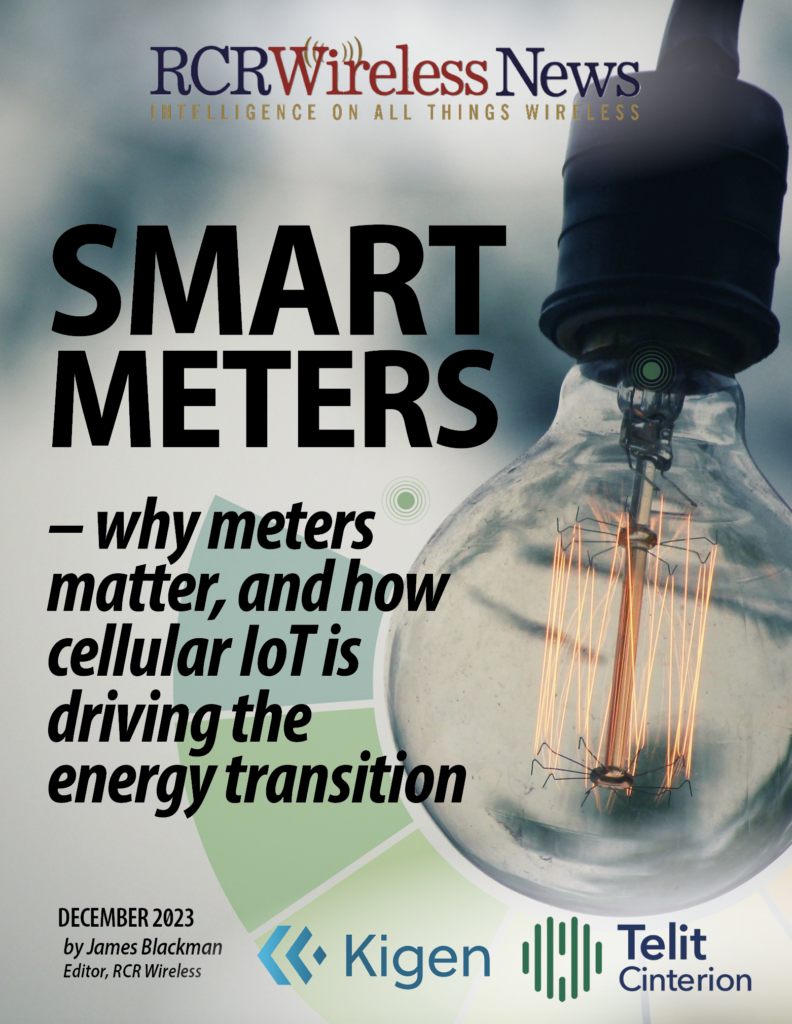Note, this article is taken from the upcoming RCR Wireless editorial report on smart meters, and is spliced together from different excerpts from the report. The report – called, Smart Meters: Why Meters Matter, and How Cellular IoT is Driving the Energy Transition – will be out by the end of the week. Check back here.
If we accept the planet faces an existential crisis in terms of how energy is generated and consumed, and we accept the business adage (sales gambit) that you can’t manage what you can’t measure, then smart meters are arguably the single most important technology out there. This is hyperbole, of course; but you get the point. If society is in a race against time to change and manage the energy mix, and save itself from a climate apocalypse, then it needs the tools to mark its progress. The humble smart meter is the tool to save us all – so long as politicians and corporations are ambitious, brave, and correct with the data insights that flow out of it.
…
But how did we get here? And where is here, anyway? What has changed? Because meters have been designated as ‘smart’ for two decades already? So why are we writing about them in late 2023 when there appears to be much zingier IoT gadgetry to discuss – such as machine vision and augmented reality, or intelligent transport systems and lights-out factories (anyone?). The answer to this last question is that the gargantuan IoT sector basically splits into two parts – asset monitoring and asset tracking – and metering, one way or another, covers all of this first discipline.
This is the case, effectively, whether the metering runs in conventional AMI systems or as an audit function in all manner of other sensors – whether they are attached to lighting systems, environmental controls, or most of these more fanciful industrial IoT process applications. This report is only interested in conventional (smart) utility meters, which remain the biggest market for asset monitoring by far. The tracking discipline, it might be noted, has developed out of the M2M market in parallel, and is similarly overshadowed by its original killer app: automotive telematics.
Jean-Marc Lafond, director of Orange’s IoT innovation portfolio, makes the point, and draws the distinction. “The two big markets [for IoT] are automotive and utilities. And they are fundamentally different because the goal with automotive is to have an offer that is international, without borders. Automotive makers want it to work in the same way in every country. Which is challenging, of course. On the opposite side, utilities work in their own national and domestic markets – which is challenging in a different way, because the solution might be completely different one-country to the other.”
We will unpick some of this regional market chaos, as we go (in the report). But we are also writing about meters just because they are the most viable and most proven application in the IoT business, and because their role in global energy transition, as the defining challenge of our time, is critical. But what about that first question: how did we get here? US energy tech giant Itron has taken a leading role over two decades, in the whole creation myth. Ty Roberts, 25 years with the firm, has seen it all, latterly as vice president of its marketing and network solutions. He picks up the narrative, and brings us up to date. It is a story worth telling, and worth quoting in full. It goes like this…

“The whole market started maybe 15 years ago when the cost of radios came down. Utilities could build a business case to read their meters over the air. And with two-way comms, they could also connect and disconnect, and collect outage and restoration notifications. When you put those three things together – over-the-air readings, service switching, service restoration – electric utilities suddenly found that they could redeploy field agents, set to go out and read meters on a daily basis, to do other things – and save the money from that.
“Which meant the business case – to install meters, plus a network – was net-positive in 10-20 years. And lots of utilities made their money back a little faster. That is when the electric world – especially in North America, but also in pockets of Europe – really started to deploy AMI solutions en masse. Pretty much all of the tech was built for purpose at that time. Because cellular was too expensive, and there were worries about how long carriers would support each generation of network tech – raising the prospect they would have to replace the radios at some point, and break the business case.
“Which drove the deployment of [proprietary] radio frequency (RF) mesh solutions in North America and Australia, in particular – which were low-cost, resilient, and designed to meet the specific use cases for utilities. So that was the predominant architecture at the time. There are other solutions out there, of course – point-to-multipoint, different radio frequency solutions; there are some PLC solutions in France, Italy, and Spain in particular. But these have all essentially been non-cellular solutions.
“What we didn’t see at that time was large-scale adoption of the same two-way comms for gas and water utilities. There are a couple of reasons for that. The main one is power. You need power to these radios to be able to communicate. Electric meters have power right there, of course; gas and water [networks] don’t. The other challenge is that gas and water companies often don’t have assets they can mount negtwork gear onto – in order to host network hardware in the field. They just don’t have the infrastructure to mount all of these routers, repeaters, collectors.
“So the cost to deploy a two-way network has been really high for them – because they had to solve the power problem, and they had nowhere to put the assets. And what has been done [for smart water and gas metering], until pretty recently, is to deploy radios that you read on a drive-by every month or less. It is only in the last few years with LTE-M and NB-IoT that cellular is optimised for battery-powered devices. Rollout of those technologies means a broader range of gas and water utilities can use low-power cellular to read their meters over-the-air.
“[As for cellular in electricity metering], this is the utility industry, so very little happens in a rush. Which is because utilities are working to 15- or 20-year cycles. These AMI projects deliver a return by being in the field for a long time. Once these devices are deployed, they don’t touch them if they can help it – by design. Which means nothing changes very quickly. So utilities, deploying solutions for the first time, have to make a choice about which technology to go with, and then live with that decision for a long time.
“With that said, cellular is absolutely becoming a viable technology – certainly in the gas and water market. These utilities are building business cases for two-way AMI for the first time. So in gas and water, yes, cellular is catching up fast, and we’re starting to see real volumes there. On the electric side, we are still deploying mesh solutions today. That is starting to pivot towards cellular in some parts of the world, but it is still a mostly-mesh landscape. But that will change. We will see far more cellular being deployed [for electric AMI] in the next few years, maybe a little longer. The market will shift from mostly-mesh to mostly-cellular.”
All of which tells us just about everything we need to know about this business: its original function, to provide remote access and control; the hot mess of (non-cellular) tech that has grown up in its wake; the luck of electric metering, to have a ready power supply; the challenges with gas and water metering, to trade power and performance on battery-powered units, plus the lack of infrastructure to host private IoT networks; the slow change and critical nature of the utility market; and the late rise of low-power cellular IoT as a well-made connectivity and ready-made network solution for all different metering disciplines. It is all here; we just need to pick through it a piece at a time.
This article is continued and expanded in the upcoming RCR Wireless report on smart meters, out this week. Check here for updates.


